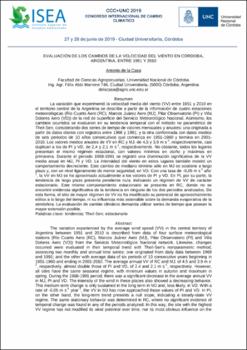| dc.contributor.author | de la Casa, Antonio Carlos | |
| dc.date.accessioned | 2024-02-19T15:29:46Z | |
| dc.date.available | 2024-02-19T15:29:46Z | |
| dc.date.issued | 2019 | |
| dc.identifier.uri | http://hdl.handle.net/11086/550527 | |
| dc.description | Ponencia presentada en el Congreso Internacional de Cambio Climatico (CCC) y Tercer Encuentro Interdisciplinario de Investigadores en Problemáticas Ambientales (EIDIPA). Córdoba, Argentina, 26 al 28 de junio del 2019. | es |
| dc.description.abstract | La variación que experimentó la velocidad media del viento (VV) entre 1951 y 2010 en el territorio central de la Argentina se describe a partir de la información de cuatro estaciones meteorológicas (Río Cuarto Aero (RC), Marcos Juárez Aero (MJ), Pilar Observatorio (PI) y Villa Dolores Aero (VD)) de la red de superficie del Servicio Meteorológico Nacional. Asimismo, los cambios ocurridos se evaluaron en su tendencia temporal con el método no paramétrico de Theil-Sen, considerando dos series de tiempo de valores mensuales y anuales: una originada a partir de datos diarios con registros entre 1968 y 1991; y la otra conformada con datos medios de seis periodos de 10 años consecutivos que comienza en 1951-1960 y termina en 2001-2010. Los valores medios anuales de VV en RC y MJ, de 4,5 y 3,9 m s-1, respectivamente, casi duplican a los de PI y VD, de 2,4 y 2,1 m s-1, respectivamente. No obstante, todos los lugares presentan el mismo régimen estacional, con valores mínimos en otoño y máximos en primavera. Durante el periodo 1968-1991 se registra una disminución significativa de la VV media anual en MJ, PI y VD. Este cambio de mediano término sólo en MJ se sostiene a largo plazo y, con un nivel ligeramente de menor seguridad, en VD. Con una tasa de -0,05 m s-1 año-1, la VV en MJ se ha aproximado actualmente a los valores de PI y VD. En PI, por su parte, la tendencia de largo plazo presenta una pendiente nula, indicando un régimen de VV de carácter estacionario. Este mismo comportamiento estacionario muestra RC, donde no se encontró evidencia significativa de la tendencia en ninguno de los dos periodos analizados. De esta forma, el sitio de mayor régimen de VV no ha modificado su potencial de aprovechamiento eólico a lo largo del tiempo, ni su influencia más ostensible sobre la demanda evaporativa de la atmósfera. La evaluación de cambio climático demanda utilizar series de tiempo que posean la mayor extensión posible. | es |
| dc.description.abstract | The variation experienced by the average wind speed (VV) in the central territory of
Argentina between 1951 and 2010 is described from data of four surface meteorological
stations (Río Cuarto Aero (RC), Marcos Juárez Aero (MJ), Pilar Observatorio (PI) and Villa
Dolores Aero (VD)) from the Servicio Meteorológico Nacional network. Likewise, changes
occurred were evaluated in their temporal trend with Theil-Sen's nonparametric method,
assessing two monthly and annual time series: one originated from daily data between 1968
and 1991; and the other with average data of six periods of 10 consecutive years beginning in
1951-1960 and ending in 2001-2010. The average annual VV of RC and MJ, of 4.5 and 3.9 m s-
1, respectively, almost double those of PI and VD, of 2.4 and 2.1 m s-1, respectively. However,
all sites have the same seasonal regime, with minimum values in autumn and maximum in
spring. During the 1968-1991 period, there was a significant decrease in the average annual VV
in MJ, PI and VD. The intensity of the wind in these places also showed a decreasing behavior.
This medium-term change is only sustained in the long term in MJ and, less likely, in VD. With a
rate of -0.05 m s-1 year-1, the VV in MJ has now approached those values of PI and VD. In PI,
on the other hand, the long-term trend presents a null slope, indicating a steady-state VV
regime. The same stationary behavior was determined in RC, where no significant evidence of
temporal change was found in any of the periods analyzed. In this way, the site with the highest VV regime has not modified its wind potential over time, nor its most obvious influence on the evaporative demand of the atmosphere. The climate change evaluation demands the use of time series that have the greatest possible extension. | en |
| dc.language.iso | spa | es |
| dc.rights | Attribution-NonCommercial-NoDerivatives 4.0 Internacional | * |
| dc.rights.uri | http://creativecommons.org/licenses/by-nc-nd/4.0/ | * |
| dc.source | CCC 2019 + 3 EIDIPA. Congreso Internacional de Cambio Climatico (CCC) y Tercer Encuentro Interdisciplinario de Investigadores en Problemáticas Ambientales (EIDIPA) | |
| dc.source.uri | https://eidipa.congresos.unc.edu.ar/ | |
| dc.subject | Viento | es |
| dc.subject | Velocidad | es |
| dc.subject | Theil-Sen | es |
| dc.subject | Córdoba | es |
| dc.subject | Argentina | es |
| dc.title | Evaluación de los cambios de la velocidad del viento en Córdoba, Argentina, entre 1951 y 2010 | es |
| dc.type | conferenceObject | es |
| dc.description.fil | Fil: de la Casa, Antonio Carlos. Universidad Nacional de Córdoba. Facultad de Ciencias Agropecuarias; Argentina. | es |
| dc.conference.institution | Universidad Nacional de Córdoba (UNC) | |
| dc.conference.institution | Instituto Superior de Estudios Ambientales (ISEA) | |
| dc.conference.type | Congreso | |





